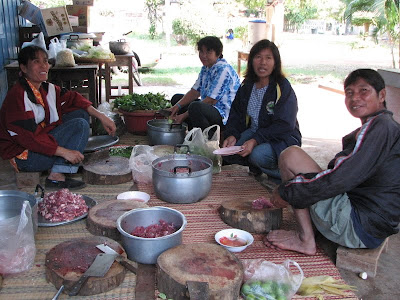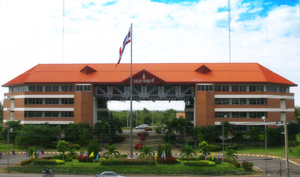Missing his family ......... the roast pork and cabbage
But I am with Isan......no need to be flurried
My friends pick me up.......there's no need to pack baggage
And no time to be lonely ..... unhappy or blue
The school’s having a party ......... “No homesick for You!!!”
I was thinking of the poem about the mouse and the quiet and the day before Christmas and what I would do for the day. Christmas Eve and Christmas Day are working days in Thailand and there had been none of the hype I am used to experiencing at home in Wollongong leading up to Christmas. Sure, there were a few Christmas trees, elaborate and beautiful; full of lights but understood by many Thais as only a marketing tool to make some money at Christmas.
I awoke wondering whether I would feel homesick on Christmas Eve .... silly boy! I am in the middle of Isan. Isan people do not let you feel lonely.
My mobile rang early (6 am) and my good schoolteacher friends Aoy and Tookie invited me to their school to see a small celebration at which Aoy’s daughter was participating as a marching girl.
“OK”; I said. Shower, dress ... toot toot and into the car for Borabu.
We picked up Aoy’s daughter and her 2 marching girl friends and drove to the middle of a village somewhere (I never get used to this... ) where at first glance I saw a couple of kids dressed up, a bit of a school drum band and some more kids with banners. Remember, I have no idea where I am!!!Aoy and Tookta disappeared, reappeared and, seizing the opportunity I asked my usual question; “What do I do?”“Follow the children”; was the short retort and I was on my own again.
OK........
......follow them ........
......... where???

The drums starting beating: schoolkids love banging drums and so I did as I was told and followed along the narrow village street. Look! More children up ahead – time for photos..... and more drums .. and more marching girls ... and more children !! I went along a bit until my leg tired and I started limping. A schoolchild stopped his motor cycle and offered me a lift; typical of the jai dee all Isan people show me.
The procession wound it’s way through the streets of the village for perhaps 4 kilometres withparents, uncles, aunties, mothers, grandmothers (you get the idea) lining the sides of the narrow village avenues smiling and clapping the children and saying hello to the novelty of the farang.
How to describe the procession?? Three kilometres long of marching girls being led by children dressed in traditional Isan garb with a drum band to keep time, some soccer teams and volleyball teams and then more of the same, all proceeding along the village lanes proudly watched by the whole village who turn out to watch them pass by.
This is a feeling of community spirit that is repeated at the same time all over Isan. EVERYBODY participates in some way, not because they have to, because they WANT to.

Off to the school sportsground for a grand parade and march past; the ever present VERY loud PA system producing continuous commentary on the procession and sporting events throughout the day. The loud PA seems a bit much at first although it is easy to become accustomed to and really lends excitement to the day.

The assembly was impressive once they all arrived.
The march past was lots of fun to watch - the girls really stepped out in style for the appreciative crowd.

Something I really enjoyed was the sense of having competitions where the emphasis was on participation instead of individual achievement. I positioned myself close to the cold water and coffee, as you do at such events, situated just behind a trophy table which display ed a selection of magnificent trophies.
I did not notice any of the children during my time there come to the table to admire the trophies. I certainly did.
I may be wrong although from what I saw the emphasis was not on individualism as opposed to participation. There were no tantrums noticeable if a child lost a race or did not perform well. Teams were happy to win their games and teams that lost were smiling also. I think they were all their to have some fun making all participants winners.
The young girls passing the trophies to the presenters wore traditional Isan silk..... how they managed to look so fresh all day is a secret I would like to have shared.
It is just one small example of the rich culture and sense of wholehearted ISAN community spirit. I am not made to feel like an outsider; friend and stranger alike make me feel welcome, as if I have an open invitation to join in as a part of the community where I am treated as one of their own. Toyota has nothing on this feeling!!
Lunch was provided by the school and everybody joined in together. The picture at right is of a part of the kitchen.
Food does not get much fresher than what is provided in Thailand.
I have been here since November 1 and the only tin I have opened is the one containing the shoe polish. Oh! Did I mention it hasn't rained either but there is still plenty of water about.
 Volleyball,
Volleyball,soccer volleyball,
soccer,
foot races,
relays,
steel bowls
and we'll have a measure on
that one

and plenty of water and shade provided for everyone.
Even a little fat farang man showed up to bring some extra entertainment and to join in the festivities.

More importantly I was once again treated to a hospitality from the Isan people which I have never experienced in any western culture.

I am not saying it is better, I am saying it is something which keeps me smiling every day here in Thailand
I did not forget about my family home in Australia on Christmas Eve, but definitely
...... "No time to be lonely
..... or homesick or blue
The school’s having a party
......... “No homesick for You!!!

PS. My good friends surprised me with Christmas decorations, a Christmas tree and a small party after the day’s festivities ...... more Isan jai dee !!!!
Thanks Tookie..Thanks Aoy ... Thanks Eve ... you are in my heart forever.














 IRO Home Page
IRO Home Page
 FYI
FYI
 e-mail Freeman64
e-mail Freeman64
 Talk to me
Talk to me
 About me
About me
 My Digg articles
My Digg articles
 Lots of pics
Lots of pics
 Pra Santi
Pra Santi
 Pepe
Pepe
 Jo Kay
Jo Kay
 Tookta
Tookta
 Chai
Chai
 Min
Min
